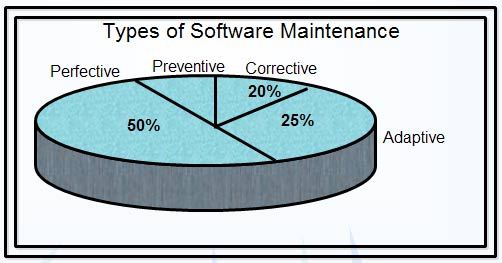There are four types of maintenance, namely, corrective, adaptive, perfective, and preventive. Corrective maintenance is concerned with fixing errors that are observed when the software is in use. Adaptive maintenance is concerned with the change in the software that takes place to make the software adaptable to new environment such as to run the software on a new operating system. Perfective maintenance is concerned with the change in the software that occurs while adding new functionalities in the software. Preventive maintenance involves implementing changes to prevent the occurrence of errors. The distribution of types of maintenance by type and by percentage of time consumed.
Corrective maintenance deals with the repair of faults or defects found in day-today system functions. A defect can result due to errors in software design, logic and coding. Design errors occur when changes made to the software are incorrect, incomplete, wrongly communicated, or the change request is misunderstood. Logical errors result from invalid tests and conclusions, incorrect implementation of design specifications, faulty logic flow, or incomplete test of data. All these errors, referred to as residual errors, prevent the software from conforming to its agreed specifications. Note that the need for corrective maintenance is usually initiated by bug reports drawn by the users.

In the event of a system failure due to an error, actions are taken to restore the operation of the software system. The approach in corrective maintenance is to locate the original specifications in order to determine what the system was originally designed to do. However, due to pressure from management, the maintenance team sometimes resorts to emergency fixes known as patching. Corrective maintenance accounts for 20% of all the maintenance activities.
We’ll be covering the following topics in this tutorial:
Adaptive Maintenance
Adaptive maintenance is the implementation of changes in a part of the system, which has been affected by a change that occurred in some other part of the system. Adaptive maintenance consists of adapting software to changes in the environment such as the hardware or the operating system. The term environment in this context refers to the conditions and the influences which act (from outside) on the system. For example, business rules, work patterns, and government policies have a significant impact on the software system.
For instance, a government policy to use a single ‘European currency’ will have a significant effect on the software system. An acceptance of this change will require banks in various member countries to make significant changes in their software systems to accommodate this currency. Adaptive maintenance accounts for 25% of all the maintenance activities.
Perfective Maintenance
Perfective maintenance mainly deals with implementing new or changed user requirements. Perfective maintenance involves making functional enhancements to the system in addition to the activities to increase the system’s performance even when the changes have not been suggested by faults. This includes enhancing both the function and efficiency of the code and changing the functionalities of the system as per the users’ changing needs.
Examples of perfective maintenance include modifying the payroll program to incorporate a new union settlement and adding a new report in the sales analysis system. Perfective maintenance accounts for 50%, that is, the largest of all the maintenance activities.
Preventive Maintenance
Preventive maintenance involves performing activities to prevent the occurrence of errors. It tends to reduce the software complexity thereby improving program understandability and increasing software maintainability. It comprises documentation updating, code optimization, and code restructuring. Documentation updating involves modifying the documents affected by the changes in order to correspond to the present state of the system. Code optimization involves modifying the programs for faster execution or efficient use of storage space. Code restructuring involves transforming the program structure for reducing the complexity in source code and making it easier to understand.
Preventive maintenance is limited to the maintenance organization only and no external requests are acquired for this type of maintenance. Preventive maintenance accounts for only 5% of all the maintenance activities.
